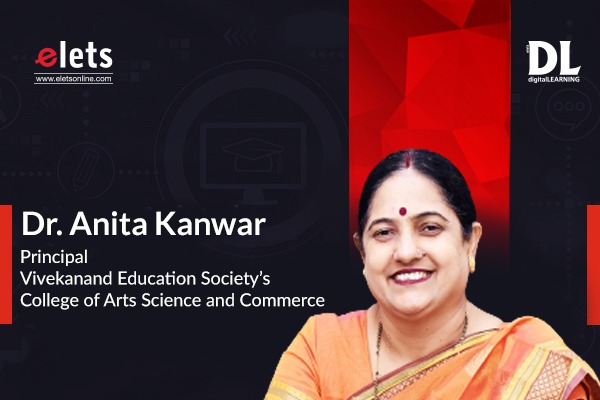
Massive unemployment followed post-pandemic, and during pandemic, amendments in the education system can be a panacea to all. The evolving concept of multidisciplinary framework is another great step taken under the NEP , that can create immense opportunities for students after completing their degrees. Sheeba Chauhan of Elets News Netwrok (ENN) interacted with Dr. Anita Kanwar, Principal, Vivekanand Education Society’s College of Arts Science and Commerce to elucidiate on the current scenario in higher education system. Edited excerpts:
The education sector has evolved largely, from ensuring that no student is left out of schools to bridging the digital gap in government colleges; every thing is taken care of by the government of India . The sector that needed much attention, is finally grasping the utmost pace, with some major alterations. Higher education is also at the focus, we have recently witnessed some major changes that are introduced by University Grant Commission (UGC) for the Higher Education Institutions (HEIs) in India.
Riding the digital transformation and innovation, educators are also looking forward to the continuous development. Though there are some pitfalls, the glad tide is that it is gaining the traction of improvement. Some of the recently announced frameworks for higher education, be it CUET (Central Universities Entrance Test) or ‘Single Entry, Multiple Exit’ , these are bringing new light and enhancement to the quality education.
Under the implementation of NEP, “Single Entry, Multiple Exit System” emerged as the game changer for the education system. What are your thoughts on the same?
The multiple entry system is likely to reduce the pressure of pursuing a course with an opportunity of zero-year loss in the academic journey. It will give students more freedom and flexibility, allowing them to switch courses if they want to learn about a different industry. This is likely to revolutionise India’s higher education system, as only interested students will complete the degree through a multiple entry and exit point system. With continuous reforms in this direction, this game-changing move will make our higher education system more like the global format. Given the facts stated above, a multiple entry and exit system appears to be a very positive change. However, a more in-depth examination of the concept raises only a few questions. However, a more in-depth examination of the concept reveals a few practical issues. Curriculum development is a significant challenge in implementing this system. What level of proficiency will a student achieve after one or two years of a degree program? As a result, the curriculum must be revised to include the specialised competencies, knowledge, and skills required in a specific subject area. Overall, implementation will be difficult.
When it comes to things like transfers across schools or states, blockchain can eliminate much of the overhead associated with this process and streamline verification procedures, saving educators and administrators time. A college enrolling a transfer student might use blockchain to authenticate their record and the courses they studied with a few simple clicks. The same idea applies to sharing records with an employer.
You have a robust campus and infrastructure developing engineering graduates. Engineers are one of the professions that gathers much traction these days. With the emerging technologies all around, what according to you can be the next set of skill sets that engineers must have?
According to emerging technologies, the next skill set for engineers to focus on is digital data management and analysis. Data management in business includes metadata management, data quality management, and data security management. Furthermore, due to the complexity of data and data applications in the smart data era, data engineering must integrate both AI and human wisdom to maximise its effectiveness.
Launch of the Autonomous Courses, how the new programme aims to bridge the skill gap among the fresh graduates?
Massive unemployment has occurred as a result of massive automation and the pandemic. The current skill gap exists between what students learn after graduation and what employers require. Following the pandemic and the changing job market landscape, VESASC with its autonomous courses has focussed on providing a curriculum centered on new-age, industry-specific skill sets. Recognising the significance of overall student development in transforming students into future ready professionals, the core curriculum emphasises technical and vocational education combined with new-age skills to aid employment. To pave the way for a reformative educational culture, the education ecosystem must adopt an interdisciplinary approach as well as adaptable and diverse curricula that provide a creative blend of theoretical and practical topics with multiple exit options. Institutes have already begun to implement practical research and development study programs. Many talents must be developed in the areas of sector-specific, core, professional, and technical skills.
What is the purpose of the innovation and start-up cells of Vivekanand Education College?
Our innovation and start-up cell’s main goal is to create a vibrant ecosystem by connecting academia, financial institutions, industries, and other institutes. Along with the placements, we are also focusing on instilling a culture of innovation-driven entrepreneurship.
Your journey must have been fascinating and challenging. Enlighten us through some of your life hurdles and successes that you came across in the immense world of education.
Every day, principals face new challenges in their efforts to create a strong student education ecosystem. One of the most difficult tasks I’ve had in my journey has been planning and streamlining a more comprehensive and all-encompassing curriculum. To address this, I have formed alliances with academicians & industry experts and developed customised outcome-based education that will map competencies and standards to improve learning outcomes. Today, this is commonly referred to as VESASC Autonomous courses, which have gained strong popularity among students.
In the evolving landscape of education, like recent amendments in NEP, introduction of CUET for admissions, and a lot more. How are you planning to adapt to these changes? What are your plans for expansion of your institutions?
We are collaborating closely with academia and industry experts to develop new courses for the upcoming academic year that are in line with NEP and market demands. We have already announced addon and value-added certificate courses to enhance the teaching and learning experiences of our students.





















